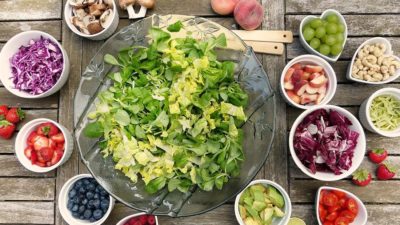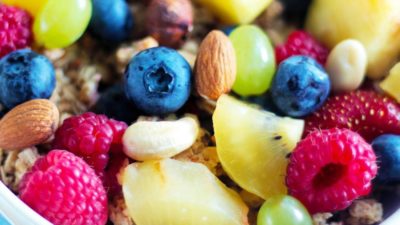What every parent should know when raising vegan babies and children

Raising vegan children can be a tough job – not because of meal planning but rather due to the constant scrutiny of those around you. Luckily, the more vegan children there are, the easier it gets!
What all parents need to know
Children must be well-nourished to grow and develop in the best possible way. All parents and carers should plan their children’s diet to include all the essential nutrients – whether they’re vegan or not.
However, a varied vegan diet offers advantages – the best start to a healthy life. It provides all the necessary and beneficial nutrients and it lacks the nasty chemicals and carcinogens found in animal products.
“It is the position of the Academy of Nutrition and Dietetics that appropriately planned vegetarian, including vegan, diets are healthful, nutritionally adequate, and may provide health benefits for the prevention and treatment of certain diseases. These diets are appropriate for all stages of the life cycle, including pregnancy, lactation, infancy, childhood, adolescence, older adulthood, and for athletes.” Academy of Nutrition and Dietetics, 2016.
Research shows that vegan children grow and develop normally and tend to be leaner (but within the healthy range) than their meat-eating counterparts. They have a lower risk of obesity, type 2 diabetes, heart disease and some cancers later in life. Vegan kids are also less exposed to veterinary antibiotics found in animal products and have lower levels of inflammation. In fact, one study found that vegetarian children had lower levels of inflammatory molecules linked to diabetes, obesity and heart disease in their blood.
Healthy vegan babies and toddlers
When it comes to practical guidance – babies need only breastmilk for the first six months but they should also get vitamin D drops – the recommended dose is 10 micrograms (or 400 IU) a day. Breastfeeding mums should also ensure they take a daily vitamin B12 supplement (at least 50 micrograms) so enough of it passes into their breastmilk. If breastfeeding is not an option, there are non-dairy infant formulas and they are required by law to contain vitamins D and B12 – you don’t need to give your baby supplements if they are feeding on formula.
Babies shouldn’t be given food before they are six months old but if they are curious, introducing first food ‘tasters’ after four months is fine. However, the majority of their energy needs should be provided by breastmilk or formula.
From six months, you can start introducing puréed or mashed foods. These should include good iron and protein sources, such as mashed beans, lentils, chickpeas and tofu. They are best combined with nut or seed butters, avocado, sweet potatoes, bananas and other soft fruit and vegetables. Whole nuts and seeds shouldn’t be given to children under five to avoid choking hazard. Other options include bread cut into strips, pasta, age-appropriate cereal products, porridge and a little soya yoghurt. Aside from breastmilk or formula, try giving your baby small amounts of water and fruit smoothies or purées for added vitamin dose.
As your child starts eating more food and less milk, make sure they eat often – their small tummies cannot hold a lot of food so they should eat frequently. You can start adjusting their diet to your own – take out a small portion of a meal you’re cooking before you add the final seasoning. That way you’ll have a baby and adult meal version and it’s encouraging for your toddler to see you eating the same foods as them.
Although wholegrains should be encouraged later on, choose white or half-white versions of bread, pasta or rice for toddlers as these contain less fibre so your child won’t fill up too fast.
Children and teenagers
A growing child needs a lot of energy and nutrients so feed them three main meals and two or three snacks daily. Building a routine is important to ensure they eat enough. Include all the main food groups in their meals – fruit and vegetables, wholegrains, pulses, nuts and seeds – and add calcium-fortified yoghurts and drinks.
When unhealthy snacks and treats begin creeping in, it can be difficult to persuade children to eat the food they need so you may have to increase the nutritional value of their meals with a few tricks – see below.
Supplements
All children need vitamin D and vitamin B12 supplements. They (and you) also need a reliable source of iodine – it may best to use a seaweed supplement a couple of times a week as an insurance policy.
When it comes to minerals, such as iron, zinc, calcium and magnesium, children eating a varied, healthy vegan diet and enough food in general, should have a sufficient supply. If you also choose calcium-fortified plant drinks, your child will be well-nourished.
However, many children are picky eaters and it’s normal to worry about their nutrient intake. In that case, you may choose to give them a multivitamin and an omega-3 supplement. Older children can get plenty of omega-3s from flaxseed oil or ground flaxseed.
How to help kids eat better
There are many tricks to help your child eat more healthily – only some might work for you but don’t give up, time and patience are key.
- Involve your child in meal preparation – if they help cook, they will be more interested in their food.
- Cut fruit and veggies into fun shapes or sticks and combine colours – making food visually attractive encourages children to eat it.
- Stir or blend ingredients into sauces and soups to increase their nutritional value – tahini (sesame seed paste), nut butters, tofu, lentils, beans and peas.
- Grate tofu or tempeh into meals – some children might want to pick pieces out of a meal but if it’s grated, they’ll eat it.
- Blend fruit (and vegetables) into smoothies – you can also add nuts, seeds, plant milk, silken tofu or oats.
- Make energy balls – combine dried fruit, nuts and oats in a blender/food processor, to make a ‘dough’ and then shape little balls from it. Add a little cocoa for a sweet treat.
- Let your child choose between two or three options – don’t ask them what they want in general but give them a choice.
- Lead by example – eat the same foods and eat together.
- Don’t give up – children may need as many 20 or more exposures to a new food before they take to it. Always praise them for trying!







